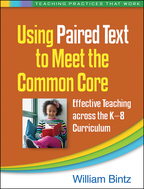Using Paired Text to Meet the Common Core
Effective Teaching across the K-8 Curriculum
William Bintz
 Read a Free Sample Chapter introducing the concept of paired text.
Read a Free Sample Chapter introducing the concept of paired text.
The reproducible materials can be downloaded and printed in PDF format.
I. Intertextuality
What Is Intertextuality?
Understanding Intertextuality
Intertextuality and Picture Books for Young Children
Intertextuality and Picture Books for Older Children
Intertextuality and Picture Books for Adolescent Readers
Intertextuality and Picture Books across the Curriculum
Intertextuality and the CCSS
Intertextuality, the Common Core, and Paired Text
II. Paired Text
What Is Paired Text?
Mini-Lesson: Seeing and Thinking Differently
Purpose of Paired Text
Paired Text and the CCSS
Types of Paired Text
Benefits of Paired Text
Paired Text and Picture Books
Picture Books and Paired Text across the Curriculum
Finding Picture Books for Paired Text across the Curriculum
Using Paired Text
III. Paired Text in English Language Arts
Mini-Lesson: Perspective and Point of View
Intertextual Connections
Paired Text, Intertextual Connections, and the CCR Anchor Standards
Additional Paired Text on Perspective and Point of View
Theoretical Model
Paired Text for ELA Standards by Grade Levels and Grade Bands
Additional Instructional Strategies
IV. Paired Text in History/Social Studies
Mini-Lesson: Drummer Boys in the Civil War
Intertextual Connections
Theoretical Model
The CCSS, the NCSS, and Paired Text
Additional Instructional Strategies
V. Paired Text in Science
Mini-Lesson: How Do Scientists Do Science?
The CCSS Reading Standards for Literacy in Science
The Next Generation Science Standards
Theoretical Model
Paired Text and the CCSS and NGSS Standards
Additional Instructional Strategies
VI. Paired Text in Mathematics
Mini-Lesson: Multiple Ways to Solve Single Problems
Intertextual Connections
More Potentials
The CCSS for Mathematics
Theoretical Model
Paired Text and Mathematical Content
Additional Instructional Strategies
Appendices
References
Picture Books Cited
Index



